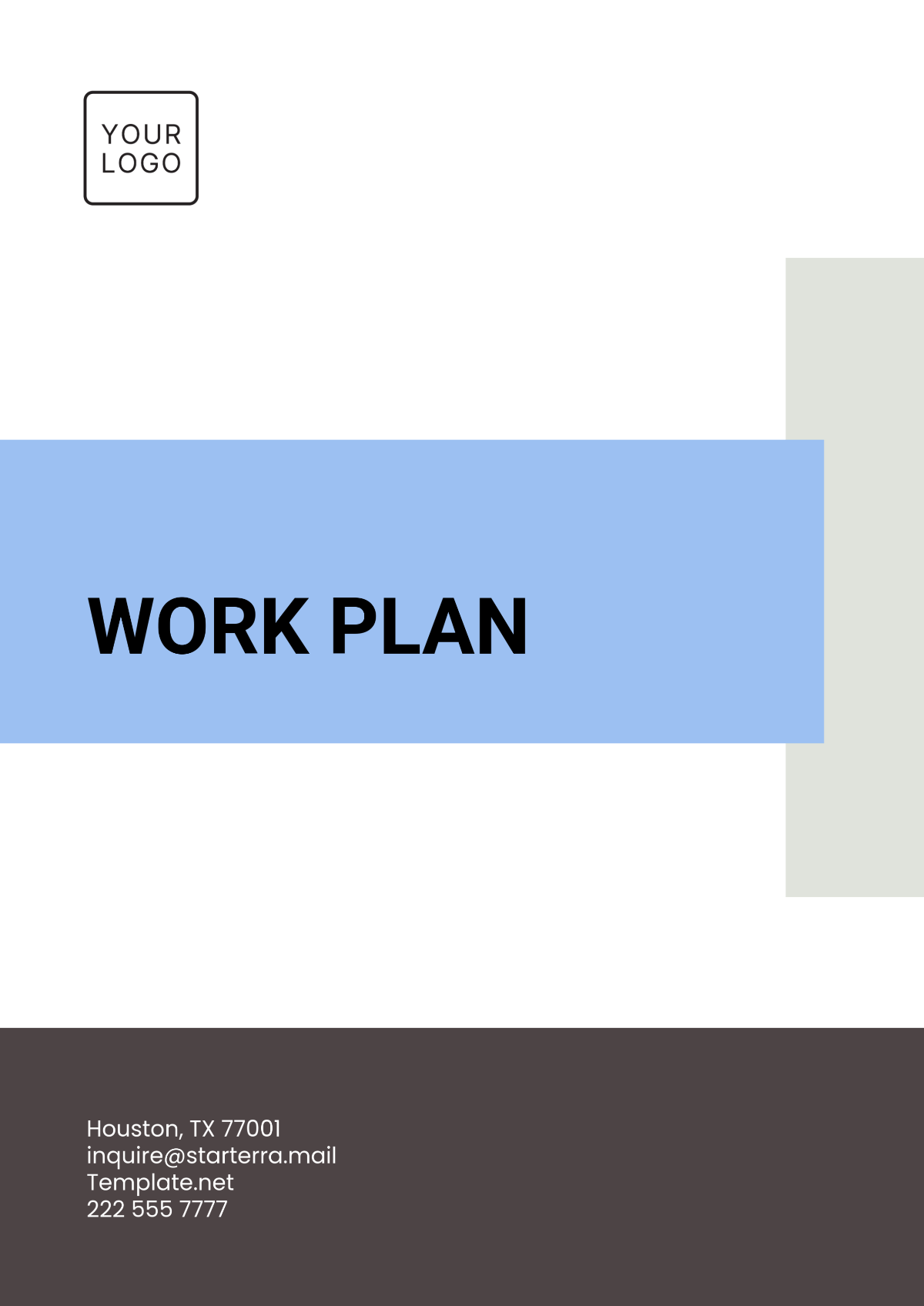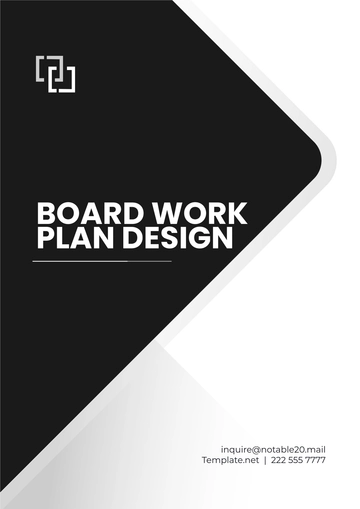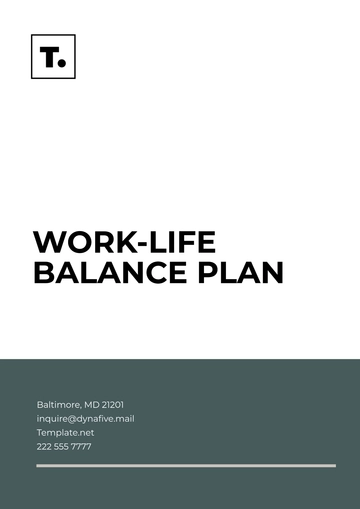Free Work Plan

Prepared by: [Your Name]
Date: [Date]
I. Objective/Purpose
The purpose of this work plan is to outline the tasks, timeline, and resources needed to organize and execute a Community Garden Project for the residents of Green Meadows Neighborhood. This initiative aims to promote sustainability, healthy living, and community engagement by transforming vacant land into a shared garden space. The project will involve gathering community input, selecting crops, preparing the land, planting, and managing the garden for the benefit of local families.
II. Tasks/Activities
A. Initial Planning
Define Project Scope: Meet with community leaders and residents to discuss the project’s objectives, needs, and scope. Identify the location of the garden and any limitations, such as size, access to water, and budget.
Conduct Community Surveys: Distribute surveys to gather input from residents on the types of plants they would like to grow, as well as any concerns or ideas they may have for the garden.
Establish Project Goals: Set clear goals for the garden, such as creating a sustainable space, providing fresh produce to families, and fostering social connections among residents.
B. Design Phase
Create Garden Layout: Develop a blueprint of the garden, including plot sizes, plant varieties, walking paths, communal spaces, and irrigation systems.
Design Common Areas: Plan communal spaces such as seating areas, gathering spots for community events, and educational sections for gardening workshops.
Gather Materials: Research and order necessary materials like soil, compost, tools, and fencing to define the garden space.
C. Land Preparation Phase
Clear and Prepare the Land: Organize community volunteers to clean up the land by removing debris, weeds, and any existing structures. Ensure the ground is leveled and ready for planting.
Soil Improvement: Test soil quality, and bring in organic compost and fertilizers to enhance soil fertility. Consider adding raised garden beds for ease of planting.
Install Irrigation System: Set up a simple irrigation system, such as drip lines or rainwater harvesting systems, to ensure the garden remains sustainable throughout the year.
D. Planting Phase
Select Crops and Plants: Based on survey results and climate considerations, select a variety of crops that will thrive in the local environment. This could include vegetables, herbs, and flowers.
Plant Seeds and Seedlings: Schedule community planting days where volunteers come together to plant seeds or seedlings in the prepared garden beds.
Incorporate Sustainable Practices: Educate volunteers on sustainable gardening techniques such as companion planting, mulching, and organic pest control.
E. Maintenance and Harvest Phase
Assign Garden Care Teams: Organize community members into teams responsible for maintaining different sections of the garden. Tasks will include weeding, watering, and ensuring that plants are thriving.
Harvesting: Set up regular harvesting days where community members can gather the produce. Use a fair system to distribute the crops among volunteers, with any excess donated to local food banks.
Host Educational Workshops: Offer ongoing workshops on topics like composting, preserving harvests, and gardening best practices to keep the community engaged.
F. Community Engagement and Events
Host Garden Tours and Festivals: Once the garden is established, host seasonal tours and gardening festivals to showcase the progress and encourage further involvement.
Build Partnerships: Partner with local schools, environmental organizations, and sustainability groups to further promote the garden’s mission.
III. Timeline/Schedule
A. Initial Planning
Start Date: January 15, 2050
End Date: February 5, 2050
Key Deliverables: Project charter, community surveys, meeting with stakeholders.
B. Design Phase
Start Date: February 10, 2050
End Date: March 5, 2050
Key Deliverables: Garden layout, material list, budget estimate.
C. Land Preparation Phase
Start Date: March 10, 2050
End Date: April 20, 2050
Key Deliverables: Cleared land, improved soil, installed irrigation.
D. Planting Phase
Start Date: May 1, 2050
End Date: May 30, 2050
Key Deliverables: Planted garden beds, and seasonal crops started.
E. Maintenance and Harvest Phase
Start Date: June 1, 2050
End Date: Ongoing
Key Deliverables: Regular harvests, volunteer coordination.
F. Community Engagement and Events
Start Date: July 1, 2050
End Date: Ongoing
Key Deliverables: Garden tours, seasonal events.
IV. Resources/Responsibilities
A. Project Manager
Responsible for overseeing the entire project, managing volunteers, and ensuring all phases are completed on schedule. Coordinates between stakeholders, sponsors, and the community.
Estimated Time Commitment: 10 hours per week.
B. Design Team
Responsible for the creation of the garden layout, selecting appropriate plant species, and ensuring the space is aesthetically pleasing and functional.
Estimated Time Commitment: 5 hours per week for the first two months.
C. Community Volunteers
Volunteers will be the backbone of the garden, contributing labor in land preparation, planting, maintenance, and harvesting.
Estimated Time Commitment: 5–10 hours per month.
D. Garden Experts/Consultants
Provide expert advice on sustainable gardening practices, soil health, and pest control. They will also conduct workshops and training sessions for community members.
Estimated Time Commitment: 2–3 hours per month.
E. Local Businesses and Sponsors
Provide necessary resources such as tools, materials, and funding. These partners may also assist with organizing community events or provide items for educational workshops.
Estimated Time Commitment: Varies, depending on the level of involvement.
V. Budget/Cost Estimates
A. Design and Layout
Estimated Cost: $2,000
Resources: Garden designer fees, printing of blueprints, survey materials.
B. Materials (Soil, Seeds, Tools)
Estimated Cost: $4,500
Resources: Soil, compost, tools, irrigation system, fencing.
C. Labor and Volunteering
Estimated Cost: $3,000
Resources: Volunteer coordination, stipends for consultant experts.
D. Events and Workshops
Estimated Cost: $1,500
Resources: Event supplies, guest speakers, promotional materials.
E. Miscellaneous Expenses
Estimated Cost: $500
Resources: Unexpected expenses, transportation, permits.
VI. Evaluation/Monitoring
A. Project Progress Monitoring
Weekly progress check-ins to assess if tasks are being completed on time. Regular status reports will be prepared by the project manager and shared with stakeholders.
Key Metrics: Percentage of tasks completed, volunteer participation rate, and satisfaction levels.
B. Post-launch Evaluation
Measure the success of the garden through community feedback, harvest yields, and ongoing engagement. A feedback survey will be sent out to participants and residents to evaluate their satisfaction.
Key Metrics: Volume of produce harvested, number of community members involved, educational impact.
C. Sustainability Assessment
After the garden has been in operation for one year, assess its long-term sustainability. This includes evaluating resource use, volunteer commitment, and overall community benefits.
Key Metrics: Long-term volunteer retention, crop yield per square foot, waste reduction.
- 100% Customizable, free editor
- Access 1 Million+ Templates, photo’s & graphics
- Download or share as a template
- Click and replace photos, graphics, text, backgrounds
- Resize, crop, AI write & more
- Access advanced editor
Stay organized with the Work Plan Template from Template.net. This fully editable and customizable template lets you outline tasks, set deadlines, and track progress effortlessly. Designed for convenience, it is editable in our Ai Editor Tool, ensuring a seamless experience for tailoring it to your specific needs. Streamline your planning process with this professional and user-friendly resource.
You may also like
- Finance Plan
- Construction Plan
- Sales Plan
- Development Plan
- Career Plan
- Budget Plan
- HR Plan
- Education Plan
- Transition Plan
- Work Plan
- Training Plan
- Communication Plan
- Operation Plan
- Health And Safety Plan
- Strategy Plan
- Professional Development Plan
- Advertising Plan
- Risk Management Plan
- Restaurant Plan
- School Plan
- Nursing Home Patient Care Plan
- Nursing Care Plan
- Plan Event
- Startup Plan
- Social Media Plan
- Staffing Plan
- Annual Plan
- Content Plan
- Payment Plan
- Implementation Plan
- Hotel Plan
- Workout Plan
- Accounting Plan
- Campaign Plan
- Essay Plan
- 30 60 90 Day Plan
- Research Plan
- Recruitment Plan
- 90 Day Plan
- Quarterly Plan
- Emergency Plan
- 5 Year Plan
- Gym Plan
- Personal Plan
- IT and Software Plan
- Treatment Plan
- Real Estate Plan
- Law Firm Plan
- Healthcare Plan
- Improvement Plan
- Media Plan
- 5 Year Business Plan
- Learning Plan
- Marketing Campaign Plan
- Travel Agency Plan
- Cleaning Services Plan
- Interior Design Plan
- Performance Plan
- PR Plan
- Birth Plan
- Life Plan
- SEO Plan
- Disaster Recovery Plan
- Continuity Plan
- Launch Plan
- Legal Plan
- Behavior Plan
- Performance Improvement Plan
- Salon Plan
- Security Plan
- Security Management Plan
- Employee Development Plan
- Quality Plan
- Service Improvement Plan
- Growth Plan
- Incident Response Plan
- Basketball Plan
- Emergency Action Plan
- Product Launch Plan
- Spa Plan
- Employee Training Plan
- Data Analysis Plan
- Employee Action Plan
- Territory Plan
- Audit Plan
- Classroom Plan
- Activity Plan
- Parenting Plan
- Care Plan
- Project Execution Plan
- Exercise Plan
- Internship Plan
- Software Development Plan
- Continuous Improvement Plan
- Leave Plan
- 90 Day Sales Plan
- Advertising Agency Plan
- Employee Transition Plan
- Smart Action Plan
- Workplace Safety Plan
- Behavior Change Plan
- Contingency Plan
- Continuity of Operations Plan
- Health Plan
- Quality Control Plan
- Self Plan
- Sports Development Plan
- Change Management Plan
- Ecommerce Plan
- Personal Financial Plan
- Process Improvement Plan
- 30-60-90 Day Sales Plan
- Crisis Management Plan
- Engagement Plan
- Execution Plan
- Pandemic Plan
- Quality Assurance Plan
- Service Continuity Plan
- Agile Project Plan
- Fundraising Plan
- Job Transition Plan
- Asset Maintenance Plan
- Maintenance Plan
- Software Test Plan
- Staff Training and Development Plan
- 3 Year Plan
- Brand Activation Plan
- Release Plan
- Resource Plan
- Risk Mitigation Plan
- Teacher Plan
- 30 60 90 Day Plan for New Manager
- Food Safety Plan
- Food Truck Plan
- Hiring Plan
- Quality Management Plan
- Wellness Plan
- Behavior Intervention Plan
- Bonus Plan
- Investment Plan
- Maternity Leave Plan
- Pandemic Response Plan
- Succession Planning
- Coaching Plan
- Configuration Management Plan
- Remote Work Plan
- Self Care Plan
- Teaching Plan
- 100-Day Plan
- HACCP Plan
- Student Plan
- Sustainability Plan
- 30 60 90 Day Plan for Interview
- Access Plan
- Site Specific Safety Plan





























